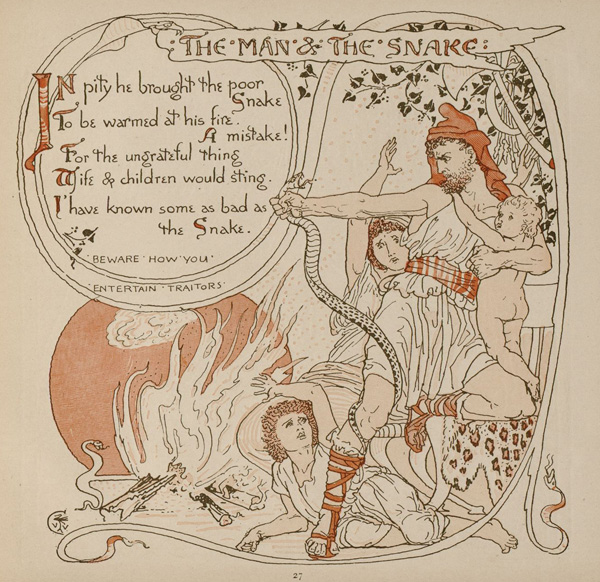Here is the version from De Furia's translation of Aesop's fables into Latin. What I especially like about this version is the elegant twist to the moral of the fable, as expressed by the dying man himself!
Vir quidam hiberno tempore iter habens, cum viperam prae gelu morientem vidisset, misericordia motus, eam sustulit, suoque in sinu refovit. Ea vero, dum frigore detinebatur, quiete ac pacate se gessit; at postquam demum calefacta fuit, illico viatoris ventrem momordit. Is itaque iam iam moriturus, "Merito quidem haec patior," inquit; "Quid enim hanc pereuntem curavi, quam etiam bene valentem interficere oportebat?" Ita quoque nonnulli homines, dum in quosdam beneficia conferent, non sentiunt se pro gratia dolores recepturos.
Here it is written out in segmented style to make it easier to follow, while respecting the Latin word order:
Vir quidam
hiberno tempore
iter habens,
cum viperam
prae gelu morientem
vidisset,
misericordia motus,
eam sustulit,
suoque in sinu refovit.
Ea vero,
dum frigore detinebatur,
quiete ac pacate se gessit;
at postquam demum calefacta fuit,
illico
viatoris ventrem momordit.
Is
itaque iam iam moriturus,
"Merito quidem
haec patior," inquit;
"Quid enim
hanc pereuntem curavi,
quam
etiam bene valentem
interficere oportebat?"
Ita quoque nonnulli homines,
dum in quosdam
beneficia conferent,
non sentiunt
se
pro gratia
dolores recepturos.
Walter Crane's image for this story is fantastic, kind of like Laocoon, but with the man having the serpent in hand this time! In Crane's version of the story, the man manages to get the snake under control before it does any actual damage.

Some dynamic content may not display if you are reading this blog via RSS or through an email subscription. You can always visit the Bestiaria Latina blog to see the full content, and to find out how to subscribe to the latest posts.
No comments:
Post a Comment